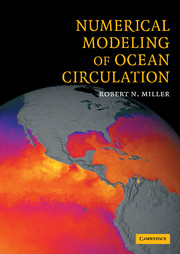1 - Introduction
Published online by Cambridge University Press: 19 February 2010
Summary
Numerical modeling has become an essential component of most research in physical oceanography. Once the domain of specialists, interpretation of model results has become part of the routine scientific practice. The highly schematic models of the 1970s and 1980s with their highly idealized geometry, coarse resolution and crudely parameterized small-scale processes could give only rough qualitative insights into applicability of theory. With the computing power available to nearly every scientist today, numerical models are expected to compare in detail with observation.
Field experiments are now designed with the intention of providing models with initial conditions, boundary conditions and verification data. Non-specialists, who, even five years ago, would not have given much thought to the implications of modeling results, now routinely ask themselves, “What do the models tell us?” Increasingly, this is the way oceanography is done.
Ocean modeling is closely related in method and spirit to atmospheric modeling, but atmospheric modeling was developed earlier, driven by the need for operational weather prediction. The basic methodology for weather forecasting was first set out by Richardson in a remarkable book (Richardson, 1965), first published in 1922. In that book, all of the steps for constructing a numerical weather forecast were set out in detail. A sample calculation was performed for two points in Europe, but the forecast turned out to be markedly different from the state of the atmosphere observed at the forecast time.
- Type
- Chapter
- Information
- Numerical Modeling of Ocean Circulation , pp. 1 - 2Publisher: Cambridge University PressPrint publication year: 2007
- 1
- Cited by



